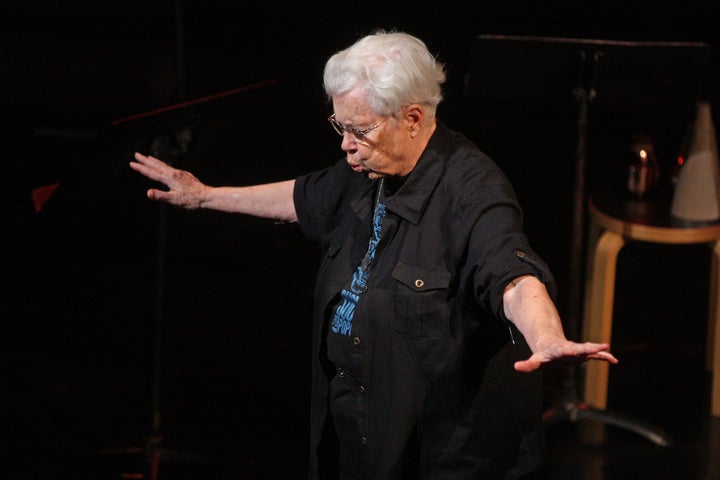
Pauline Oliveros – the avant-garde composer who died on Thursday at the age of 84 – made listening her life’s work.
Throughout her life, Oliveros worked tirelessly toward a single mission: to listen, deeply, by creating music that defied categorization, writing and teaching about the healing properties of sound, and elucidating the crucial difference between hearing and listening. The latter, especially, is of critical importance today, when truly listening to one another becomes a more and more elusive feat.
“The ear hears, the brain listens, the body senses vibrations,” Oliveros explained in a 2015 TED Talk. In other interviews she’d clarify that listening, however, is done with the heart.
The difference between hearing and listening is often referenced colloquially in conversations ― or, more likely, arguments ― in which one party feels the essence of his or her sentiments are not being digested. “You may hear me but you are not listening,” one might say. Words go, as the idiom says, in one ear and out the other.
For Oliveros, the disparity is similar, though it extends far beyond the realm of language, to encapsulate every burping frog, every humming air conditioner, every whisper of every sentient and technological thing on this earth. “To hear is the physical means that enables perception,” she said. “To listen is to give attention to what is perceived, both acoustically and psychologically.”
While hearing is an involuntary and unconscious act of the body, listening is a complicated, mysterious and entirely human activity, one that involves consciously selecting and absorbing certain sounds, while excluding others. For Oliveros, the challenge is to expand the field of what we consciously internalize, minimizing the field of things heard but not listened to, deeming every distant vibration and sigh as valuable as a speech utterance.
By this logic, the space in which music was performed held equal importance as the instruments or vocals used in said performance. In 1988, Oliveros descended a 14-foot ladder with musicians Stuart Dempster and Panaiotis to a cistern in Fort Worden, Washington, to perform in the dark, underground reservoir. Their goal was to experience the way sound’s shadows reverberate and fold over within cavernous walls. “Consider what fun it is to sing in the shower,” Oliveros said, explaining her motivation.
The experiment was dubbed “Deep Listening” ― a pun on the depth of the cistern itself, though the turn of phrase contained plenty of depth itself. Oliveros eventually made deep listening one of the core practices of her life’s work, founding the Deep Listening Institute to expand her practice.
“Deep listening for me,” Oliveros said, “is learning to expand the perception of sounds to include the whole space time continuum of sound, encountering the vastness and complexities as much as possible.”

When making music, Oliveros turned to electronic instruments to mimic the noises she encountered in the outside world often deemed inconsequential by traditional western classical tradition, such as the buzz of a cicada or the distant beep of a car alarm. When she began such experiments in San Francisco in the 1960s, she was in the vanguard of the movement along with John Cage, Terry Riley and Steve Reich, with whom she collaborated.
Although Oliveros was wary of the dangers of technology, she saw technical progress ― from early tape machines to computers ― as a means to connect human beings with each other and themselves. There is, after all, something about a murmuring engine reminiscent of a cricket’s call. Her music lands somewhere between the two, eschewing traditional melodies for stretches that connect physical landscapes with those of the imagination, exercises in sound with memories dragged into the present tense.
Many of Oliveros’ fans also valued the political ramifications of her uprooting of Western musical tradition, finding within her expansive and unorthodox musical vocabulary space for women and queer musicians, often omitted from the classical canon. In her 1970 New York Times piece, “And Don’t Call Them ‘Lady’ Composers,” Oliveros, herself a lesbian, argues for the recognition and championing of women composers and musicians.
Along with deep listening, Oliveros is most well-known for her 1971 “Sonic Meditations,” poetic instructions that illuminate the magical and challenging properties embedded in the act of listening. Each sonic meditation, as Oliveros explains in her introduction, guides individuals on “actually making sounds,” “actively imagining sounds, “listening to present sounds” and “remembering sounds.”
The meditations produce healing effects in those who practice them. The healing results from being in tune with one’s surroundings, connecting one’s interior experience with external surroundings and integrating memories with the present.
Reminiscent of Yoko Ono’s “Acorn” and “Grapefruit,” the instructions include, “Take a walk at night. Walk so silently that the bottoms of your feet become ears.” Another meditation, titled “One Word,” reads: “Choose one word. Dwell silently on this word. When you are ready, explore every sound in this work extremely slowly, repeatedly. Gradually, imperceptibly bring the word up to normal speed, then continue until you are repeating the word as fast as possible. Continue at top speed until ‘it stops.’”
Oliveros died at a moment when truly taking others’ thoughts and words into consideration feels like a daunting if not impossible task, when volume often overpowers content, when technology separates instead of connects, when the fate of listening is frighteningly uncertain.
It is more important than ever to listen, softly yet fiercely, with great attention and generosity.
“Listen to everything all the time and remind yourself when you are not listening.” Oliveros made this sentiment her mantra. It may take years to accomplish, perhaps even more than a lifetime can hold, but we must try.

